The Colossi of Memnon: A History and Guide to These Incredible Statues
Standing tall on the bank of the River Nile in Egypt are two towering statues, each measuring more than 18 meters in height. These impressive structures are known as the Colossi of Memnon, among the most iconic monuments of ancient Egyptian history. But the story behind these statues goes far beyond their massive size and breathtaking beauty. From tales of their destruction and reconstruction to legendary myths of their mysterious powers, the Colossi of Memnon have captured the imagination of visitors for centuries.
In this guide, we'll dive deeper into the history and significance of these incredible statues and show you what to expect when you visit them in person.
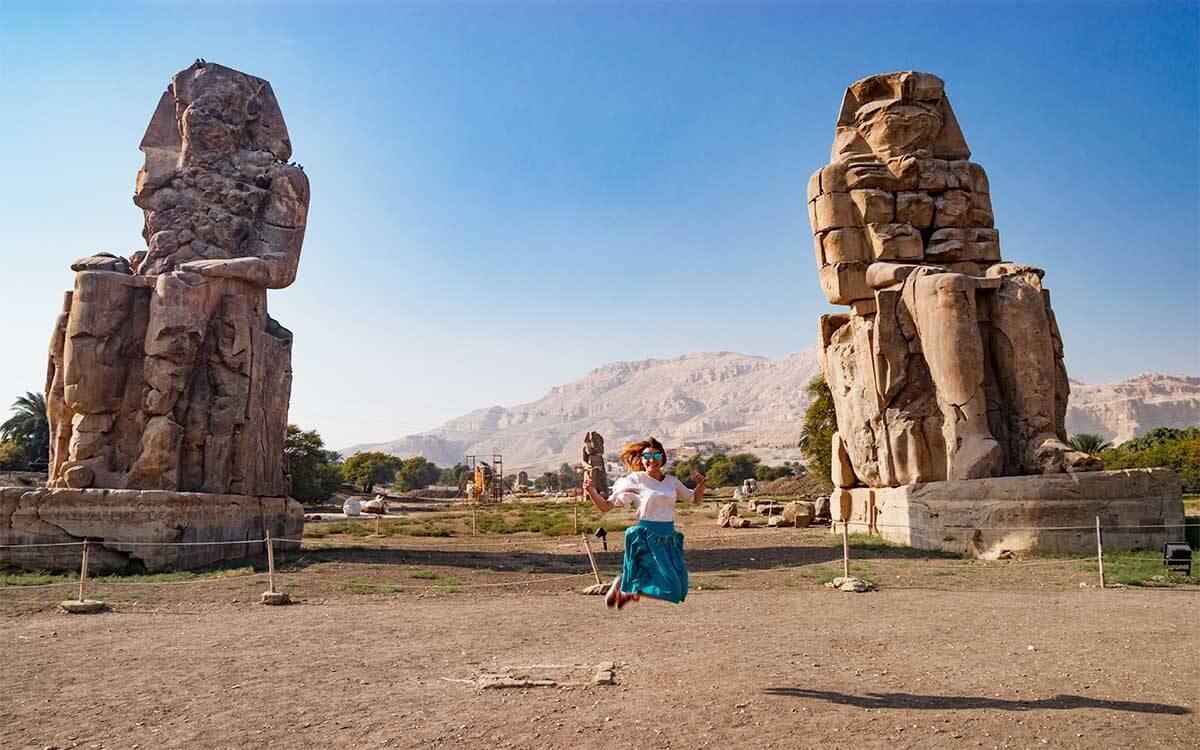
A brief overview of the Colossi of Memnon
Situated on the west bank of the Nile River, the Colossi of Memnon are two gigantic statues that have stood the test of time for thousands of years. These monolithic figures depicted the Pharaoh Amenhotep III and were originally part of his mortuary complex, which has since been destroyed. Despite their age and the damage caused by natural disasters, the statues still retain a sense of grandeur and awe. The Colossi of Memnon hold immense historical and cultural significance, making them a must-visit site for anyone interested in ancient Egypt. Here is a brief overview of these incredible statues:
- The Colossi of Memnon are two stone statues that once guarded the entrance to Pharaoh Amenhotep III's mortuary complex.
- They were constructed during the 14th century BC and are made of quartzite sandstone, which was transported from a quarry in Gebel el-Silsila.
- Each statue stands approximately 18 meters tall and weighs an estimated 720 tons.
- The statues depict Amenhotep III seated on a throne, with his hands resting on his knees and wearing the all-important royal regalia.
- The faces of the statues are believed to represent Amenhotep III, his wife Tiye, and his mother, Mutemwiya.
- The statues are adorned with intricate engravings and depictions of the pharaoh, showcasing his might and power.
- Throughout history, the Colossi of Memnon have survived numerous floods, earthquakes, and other natural disasters, proving their enduring endurance.
- Legend has it that the statues "sang" at dawn, a phenomenon attributed to the Greek hero Memnon, hence the statues' name association with him.
- Visitors can also explore nearby attractions such as the Valley of the Kings, the Mortuary Temple of Hatshepsut, and the Luxor Temple.
With its rich history and awe-inspiring presence, the Colossi of Memnon offer a fascinating glimpse into ancient Egypt's past. A visit to this site will not only provide a memorable experience but also offer insights into the cultural and artistic achievements of the ancient Egyptians. Whether you join a guided tour or explore independently, the Colossi of Memnon are a must-see destination for history enthusiasts and adventurers alike.

Importance of visiting this ancient site
Visiting the Colossi of Memnon is an experience that should not be missed when exploring ancient Egypt. These awe-inspiring statues hold immense historical and cultural significance, making them a must-see for anyone interested in ancient civilizations. Here's why it's important to include a visit to the Colossi of Memnon in your itinerary:
-
Historical significance: The Colossi of Memnon are over 3,400 years old and bear witness to the reign of Pharaoh Amenhotep III. They were originally part of the pharaoh's mortuary complex and symbolised his power and divine rule. Walking among these colossal statues provides a unique opportunity to step back in time and marvel at the grandeur of ancient Egyptian civilization.
-
Architectural marvel: The sheer size and weight of the statues is mind-boggling. Standing at a towering height of approximately 18 meters, they were carved from massive blocks of quartzite and weighed an astounding 720 tons each. Seeing these monumental structures up close is a testament to the skill and ingenuity of the ancient Egyptian craftsmen.
-
Cultural symbolism: The engravings and depictions on the statues offer valuable insights into the religious and political beliefs of the time. The figures of Amenhotep III, his wife Tiye, and his mother Mutemwiya showcase the royal family's authority and significance. Exploring the symbolism behind these representations adds depth to the historical narrative.
-
Mythical connection: The Colossi of Memnon are linked to Greek mythology through the legend of Memnon, a hero who fought in the Trojan War. According to the ancient Greeks, the statues emitted a mysterious sound at dawn, which was believed to be the voice of Memnon greeting his mother, Eos, the goddess of dawn. This mythical association adds a touch of intrigue to the site.
Visiting the Colossi of Memnon allows you to soak in the magnificence of ancient Egypt, understand its rich history, and appreciate the cultural heritage that has captivated people for centuries. Whether you're a history enthusiast or simply curious about the wonders of the past, this ancient site promises an unforgettable experience.
History of the Colossi of Memnon
Origin and purpose of the statues
The Colossi of Memnon are towering statues on the west bank of the Nile River in Luxor, Egypt. These statues, each measuring about 18 metres in height, were built during the reign of the Pharaoh Amenhotep III, who ruled over Egypt during the 14th century BC.
These statues aimed to guard the entrance of Amenhotep III's mortuary complex, a grand monument dedicated to the pharaoh. The statues were set up in a seated position, representing the pharaoh and his wife, Queen Tiye. Another theory suggests that the statues also depict Queen Mutemwiya, who was a significant figure in Amenhotep III's life.
These imposing statues were made from quartzite sandstone, transported from a quarry near Cairo, a distance of over 700 kilometres. The statues were intricately carved with various engravings and depictions, including images of the pharaoh and his family and symbolic representations of his rule and divinity. The size and weight of these statues are truly awe-inspiring, with each weighing around 720 tonnes.
The Colossi of Memnon have withstood the test of time, surviving natural disasters such as flooding and earthquakes. Today, these statues are a popular tourist attraction, offering visitors a glimpse into ancient Egyptian history and the power of Amenhotep III's rule.
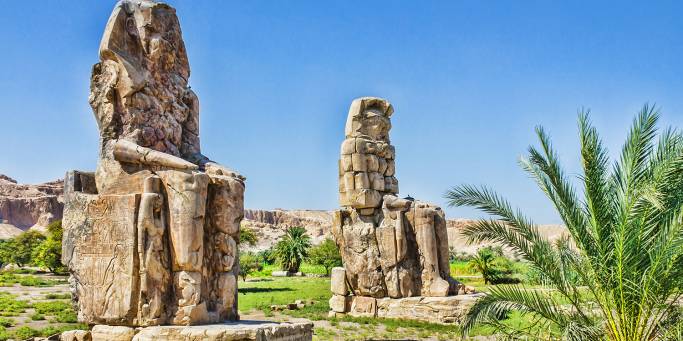
Destruction of Amenhotep III's mortuary complex
While exploring the historical background of the Colossi of Memnon, it is essential to delve into the destruction of Amenhotep III's mortuary complex. This important aspect adds intrigue to these magnificent statues. Here are some key points to consider:
• Devastation: The mortuary complex, constructed to honour the pharaoh Amenhotep III, was once a grand architectural masterpiece. Unfortunately, the passage of time and natural calamities led to its eventual ruin.
• Historical record: As per historical accounts, the complex consisted of various structures, such as temples, statues, and gardens. However, earthquakes and floods over the centuries caused significant damage, contributing to its decline.
• The flooding of the Nile: The annual flooding of the Nile River, although vital for Egypt's agriculture, often caused damage to structures, including the mortuary complex. The inundation of water weakened the foundations, leading to collapse and erosion.
• Earthquakes: Located in a seismically active region, the statues were particularly vulnerable to earthquakes. Tremors rattled the complex, causing structural instability and further contributing to its eventual disappearance.
Despite the destruction of Amenhotep III's mortuary complex, the Colossi of Memnon remain remarkable remnants, standing tall against time's relentless passage. These awe-inspiring statues continue to captivate visitors, offering a glimpse into ancient Egypt's rich history and grandeur.
Name association with the Greek legend of Memnon
The Colossi of Memnon, those magnificent statues looming tall on the western bank of the Nile in Luxor, Egypt, have a fascinating association with Greek mythology.
According to ancient Greek legend, Memnon was a hero and the son of Eos, the goddess of dawn. Memnon fought alongside the Trojans in the Trojan War, and when he was eventually slain by Achilles, his mother cried tears of grief every morning at dawn.
These tears were believed to produce a haunting sound resembling musical notes from the statues. This phenomenon led to the statues being known as the "Singing Statues" and attracted visitors from far and wide who hoped to hear the mesmerizing music.
The association with the Greek legend of Memnon adds a captivating layer of myth and mystery to these already awe-inspiring statues, making them a must-visit destination for history and mythology enthusiasts alike.
Description of the Colossi of Memnon
Size and weight of the statues
The sheer size and weight of the Colossi of Memnon are awe-inspiring. These statues stand at an impressive height of approximately 18 metres (60 feet), making them difficult to miss when visiting the site. Each statue is said to weigh around 720 tonnes, a colossal testament to the architectural skills of the ancient Egyptians. To put it into perspective, that's roughly the weight of ten fully-grown African elephants!
The enormity of these statues is further emphasized by the fact that they were carved from single blocks of quartzite sandstone, which were transported from nearly 675 kilometres (420 miles) away. The logistics and precision required for such a monumental construction project are mind-boggling.
It's no wonder that the Colossi of Memnon continue to amaze and intrigue visitors worldwide to this day.

Materials used in their construction
When it comes to the Colossi of Memnon, one cannot help but be in awe of their sheer size and magnificence. These incredible statues have stood the test of time and part of their enduring beauty lies in the materials used in their construction. Let's take a closer look at the materials that make up these monumental figures:
- Stone: The core material used in building the Colossi of Memnon is quartzite, a durable sandstone. This stone was chosen for its ability to withstand the test of time, ensuring that these statues would remain standing for centuries.
- Limestone: While quartzite forms the main structure, the statues also incorporate limestone in various parts. Limestone was primarily used for the finer details and intricate carvings of the statues, adding a touch of finesse to their overall appearance.
- Pigments: The Colossi of Memnon were once adorned with vibrant colours, with different pigments used to reveal the details and add life to the statues. The pigments, made from natural minerals and organic substances, have unfortunately faded over time, giving the statues their current weathered appearance.
These materials were carefully chosen and skillfully crafted to create these monumental works of art. The combination of durable stone and meticulous detailing with limestone and pigments showcases the craftsmanship of the ancient Egyptian artisans. It's truly remarkable to think about the expertise and vision required to create such extraordinary structures.
Symbolic engravings and depictions on the statues
When you visit the Colossi of Memnon, you'll be captivated by their sheer size and magnificence and the intricate symbolic engravings and depictions adorning these statues. Here are some key points about the symbolic elements you can expect to discover:
-
Hieroglyphic inscriptions: The statues of Amenhotep III, the pharaoh whose mortuary complex these colossi once guarded, bear numerous hieroglyphic inscriptions. These inscriptions primarily showcase the divine titles and epithets of Pharaoh Amenhotep III.
-
Scenes of offerings: You'll notice detailed carvings depicting the pharaoh offering various symbols of power and prosperity to different deities. These offerings symbolize Pharaoh Amenhotep III's divine connection and his role as a provider for the gods and his people.
-
Solar iconography: The statues feature numerous representations of the sun god Ra. This solar iconography emphasizes the pharaoh's connection to the divine and his rightful place as the ruler chosen by the gods.
-
Sacred animals: Carvings of sacred animals, such as the sphinx and the uraeus (a symbol of Egyptian royalty), are also prevalent on the statues. These animal representations highlight the pharaoh's link to mythical creatures and his association with divine power.
-
Decorative motifs: The statues are adorned with various decorative motifs, including lotus flowers, papyrus plants, and falcon feathers. These motifs carry symbolic meanings related to rebirth, abundance, and protection.
As you explore the Colossi of Memnon, take your time to admire and interpret these symbolic engravings. They provide valuable insights into the religious, political, and cultural significance of these awe-inspiring statues and the pharaoh they honour.
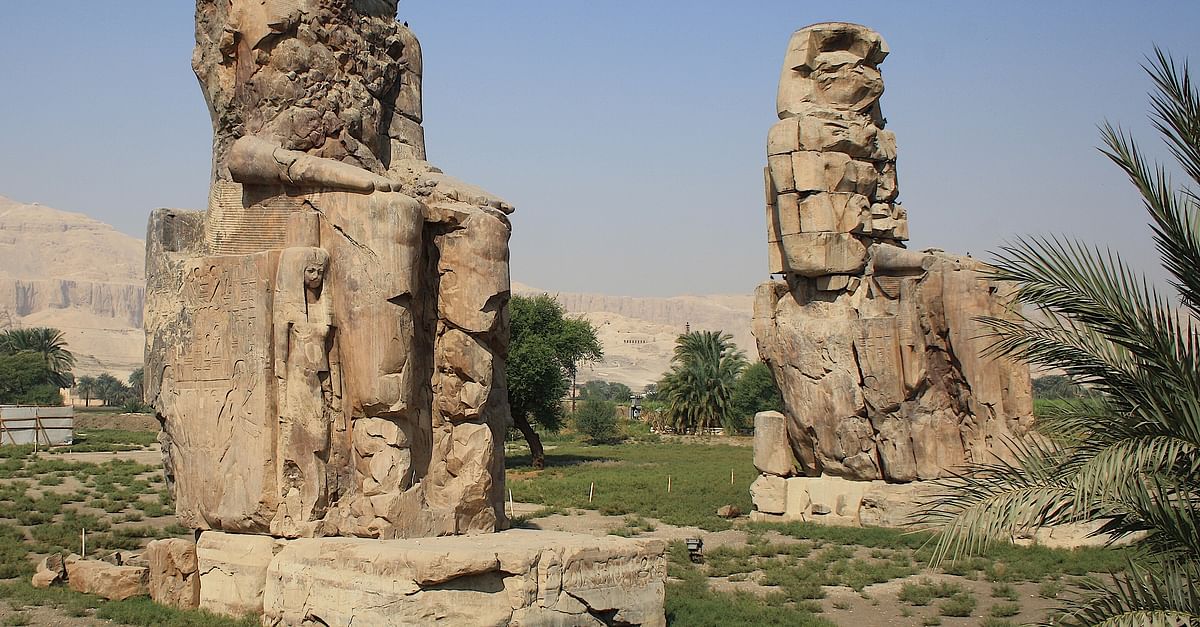
Significance of the Colossi of Memnon
Representation of Amenhotep III's rule over Egypt
When examining the Colossi of Memnon, it becomes apparent that these massive statues were not only a tribute to Pharaoh Amenhotep III but also a representation of his rule over Egypt. Here are some ways in which the statues symbolize his powerful reign:
-
Grandeur and Scale: Standing at approximately 60 feet tall and weighing around 720 tons each, the sheer size of the statues demonstrates the magnitude of Amenhotep III's rule. These colossal figures serve as a visual reminder of his dominance and authority over the Nile Valley.
-
Depictions of Amenhotep III: The statues portray Amenhotep III seated on a throne with his hands resting on his knees, a pose commonly associated with rulers. The intricate details of his facial features and royal attire showcase his regal status, emphasizing his position as the mighty pharaoh.
-
Presence of Tiye and Mutemwiya: Flanking Amenhotep III, the statues also honour his two influential queens, Tiye and Mutemwiya. This inclusion illustrates the importance and power these women held during his reign. Their presence further solidifies the narrative of Amenhotep III's strong and stable rule.
-
Endurance through Natural Disasters: Despite suffering damage over the centuries due to earthquakes and floods, the Colossi of Memnon have managed to withstand these natural disasters. This endurance aligns with the pharaoh's reputation for creating stability and prosperity during his time as ruler of Egypt.
The Colossi of Memnon is a testament to Amenhotep III's rule over Egypt, showcasing his legacy's grandeur, power, and endurance.

The symbolism behind the figures of Amenhotep, Tiye, and Mutemwiya
As you explore the mesmerizing Colossi of Memnon, it's important to understand the symbolism behind the statues. These colossal figures represent the rule of Amenhotep III over Egypt and hold great significance in Egyptian history. Here are some key points to consider:
- Amenhotep III: He is depicted as the central figure seated on a throne. Amenhotep III was a powerful pharaoh of the 18th Dynasty, and the statues symbolize his authority and might.
- Tiye: She was Amenhotep III's principal wife and held a significant position in his reign. Tiye is depicted as a smaller figure standing beside Amenhotep III, emphasizing her importance and influence.
- Mutemwiya: She was Amenhotep III's mother and is also portrayed alongside the pharaoh. Mutemwiya's presence represents the maternal lineage and her role in shaping Amenhotep III's rule.
The statues' depiction of these figures showcases their significance and the interconnectedness of their roles in Egyptian history. The attention to detail in portraying their positions and attire also reflects the grandeur and prestige of Amenhotep III's reign.
Furthermore, the endurance of the Colossi of Memnon throughout natural disasters speaks to their symbolic significance. Despite being damaged by earthquakes and other forces of nature, these statues have remained standing, a testament to the strength and resilience of Amenhotep III's rule.
Exploring the symbolism behind the figures of Amenhotep III, Tiye, and Mutemwiya adds depth and meaning to your visit to the Colossi of Memnon. It allows you to appreciate these statues' historical and cultural significance and the fascinating world of ancient Egypt they represent.
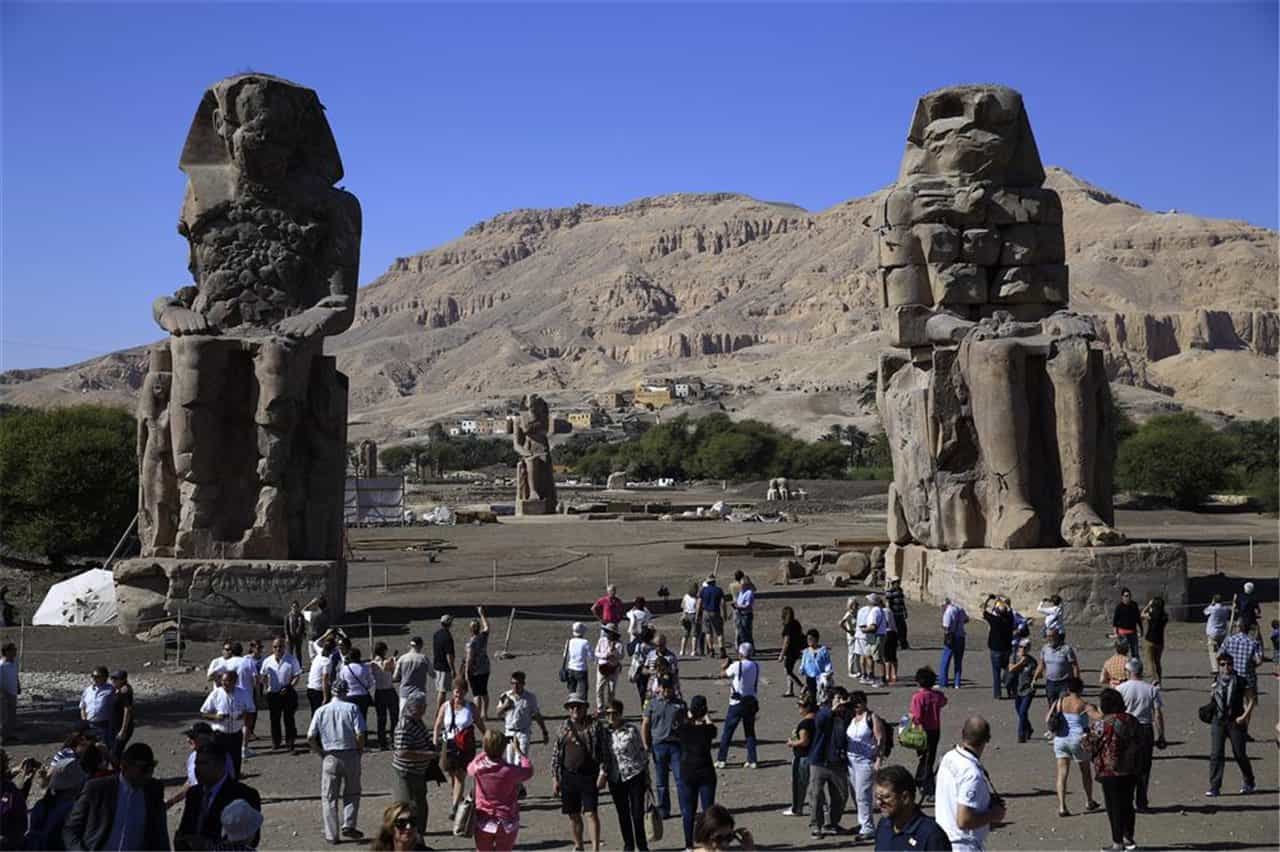
Endurance of the statues throughout natural disasters
The Colossi of Memnon have stood the test of time, enduring countless natural disasters. These colossal statues have withstood earthquakes, floods, and even the mighty Nile River. They have remained standing with each calamity, a testament to their remarkable construction and significance.
Their endurance throughout natural disasters can be attributed to several factors:
-
Solid Construction: The statues were constructed using large blocks of quartzite sandstone, a material known for its durability. This sturdy construction has allowed the statues to withstand the forces of nature and remain intact.
-
Strategic Location: The Colossi of Memnon were originally placed in front of Amenhotep III's mortuary temple, strategically positioned to protect the temple complex from potential floodwaters. This location served as an added protection against natural disasters, ensuring the statues would not be easily toppled.
-
Restoration Efforts: The statues have undergone restoration and conservation efforts over the centuries to ensure their preservation. These restoration projects have reinforced the statues, ensuring their longevity and resilience.
-
Symbolic Meaning: The Colossi of Memnon hold immense cultural and symbolic significance in Egyptian history. This symbolism may have granted them protection, as they were revered and respected by ancient Egyptians and successive civilizations.
Despite the passage of time and natural disasters, the Colossi of Memnon continue to stand tall, inspiring awe and wonder in all who visit them. Their endurance throughout the ages is a testament to the incredible craftsmanship of ancient Egyptian artisans and the enduring legacy of Amenhotep III.
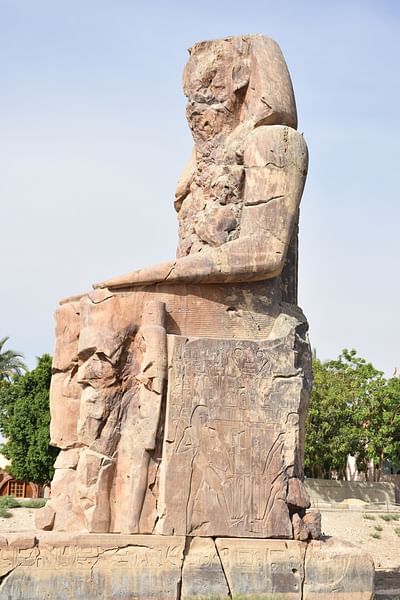
Myth and legends surrounding the Colossi of Memnon
The singing statues and their association with Greek mythology
In addition to their historical significance, the Colossi of Memnon also have an intriguing association with Greek mythology. According to the legends, Memnon, the son of the goddess of dawn, Eos, and the king of Ethiopia, was one of the Trojan War heroes. When he fell in battle, his mother mourned his loss by making the statues produce a mournful sound every morning at dawn. This phenomenon became known as the "singing statues" and attracted visitors from far and wide who were curious to hear the ethereal melodies. The mysterious sounds were believed to be the greetings of Memnon's mother, Eos, and were often interpreted as a divine acknowledgement of his heroic deeds.
The association between the Colossi of Memnon and Greek mythology adds an extra layer of allure to these fascinating statues. The experience of standing in their presence, imagining the mythical sounds that once emanated from them, is a unique and unforgettable opportunity. Whether you are a history enthusiast, a mythology lover, or simply a curious traveller, visiting the Colossi of Memnon is an experience that will transport you to ancient times and captivate your imagination.

Theories behind the sounds produced by the statues
- One of the most intriguing aspects of the Colossi of Memnon is their association with strange sounds that are said to emanate from them. Throughout history, numerous theories have emerged to explain these captivating phenomena.
- Some experts propose that the sounds are the result of temperature fluctuations. As the statues heat up during the day, the temperature difference between the inner and outer layers causes the stone to expand, creating friction that releases eerie sounds. This theory is supported by sounds being more prevalent during the day's hottest hours.
- Another hypothesis suggests that the sounds are produced by seismic activity. Egypt is located in an earthquake-prone area, and it is believed that the movement of tectonic plates could be causing the statues to vibrate slightly, resulting in resonant sounds. However, no substantial evidence has been found to support this theory.
- Some enthusiasts propose a more supernatural explanation, linking the sounds to the mythical figure of Memnon from Greek mythology. According to legend, Memnon was a hero who Achilles killed during the Trojan War. It is said that the sounds emitted by the statues are the mournful cries of Memnon's mother, Eos, who weeps for her fallen son.
- Despite the various theories, the exact cause of the sounds remains a mystery. Regardless of the scientific explanations, experiencing these peculiar sounds firsthand is an eerie and awe-inspiring experience that adds to the mystique of the Colossi of Memnon.
Planning a visit to the Colossi of Memnon
Recommended tours and attractions in the area
When visiting the Colossi of Memnon, there are plenty of other attractions and tours in the area that you can explore. Here are some recommendations to enhance your experience:
-
Valley of the Kings: Just a short distance from the Colossi, the Valley of the Kings is a must-visit. This ancient burial site is home to the tombs of pharaohs, including Tutankhamun and Ramses II. Explore the intricately decorated chambers and learn about the fascinating history of the Egyptian rulers.
-
Karnak Temple: Situated in Luxor, Karnak Temple is one of the largest temple complexes in the world. Marvel at the grandeur of its towering columns, statues, and obelisks. Take a guided tour to unravel the stories behind the temple's construction and its significance in ancient Egyptian religion.
-
Hatshepsut Temple: Named after the famous female pharaoh, Hatshepsut Temple is a remarkable architectural wonder. Located in the Valley of the Kings, this temple showcases the ancient Egyptians' elegant design and artistic mastery. Learn about Hatshepsut's reign and her contributions to Egypt's history.
-
Luxor Museum: Visiting the Luxor Museum is highly recommended to delve deeper into Egyptian art and history. Here, you'll find a vast collection of artefacts, statues, and royal mummies that offer a fascinating glimpse into the world of ancient Egypt.
-
Hot air balloon ride: For a unique perspective of the Luxor area, consider taking a hot air balloon ride. Soar above the majestic Nile River and catch breathtaking views of the ancient temples and monuments from a bird's-eye view. It's an experience you won't forget!
Whether you explore the neighbouring historical sites or take a thrilling hot air balloon ride, the area surrounding the Colossi of Memnon offers a wealth of attractions and tours that will further enrich your visit.

How to reach the site independently
If you're an adventurous traveller looking to visit the awe-inspiring Colossi of Memnon independently, fear not! Getting to this historic site is easier than you might think. Here are some helpful tips to guide you in your journey:
-
Transportation Options:
- Hire a taxi or a private car: This is a convenient and efficient way to reach the Colossi of Memnon. You can negotiate the price with the driver and have the flexibility to explore other nearby attractions at your own pace.
- Take a local bus: For a more budget-friendly option, hop on a local bus that operates in Luxor. Check the bus schedules in advance to plan your visit accordingly.
-
Directions:
- From Luxor: The Colossi of Memnon are located on the west bank of the Nile River, just outside Luxor. You can cross over to the west bank by ferry or a bridge. From there, it's a short drive or walk to the site.
- GPS or a map: If you're driving or walking, it's advisable to have a GPS device or a map handy to ensure you're heading in the right direction. The site is well-signposted, but it's always good to have a backup.
-
Entrance Fee:
- Don't forget to bring cash: There is an entrance fee to access the site, so make sure you have enough cash on hand to cover this. The fee is usually quite affordable and goes towards preserving this historical monument.
-
Time of Visit:
- Plan your visit wisely: The Colossi of Memnon can be visited throughout the day, but it's best to go early in the morning or late in the afternoon to avoid the scorching sun and crowds. This will allow you to appreciate the grandeur and serenity of the statues fully.
Following these simple guidelines will prepare you to embark on your independent journey to the Colossi of Memnon. Enjoy the experience of exploring these ancient wonders and immerse yourself in the rich history of Egypt's past. Safe travels!
